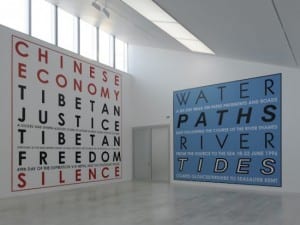A pioneer of photographic art, German artist Floris Neusüss depicts the human form, nature, and aspects of domestication through his camera-less photographs. Currently on view at ATLAS Gallery, Ancient and Modern unveils original works by Neusüss from the 1960s and 1970s that have not been previously released from his studio until now.
Neusüss portrays the ancient in a modern way in his works from the Aegineten photogram series, that include photogramic renditions of life-size ancient Greek statues from the Glypothek Museum in Munich. This older series is shown with newly released artworks from the 1970s of nudes conveyed in the same photogramic practice. Neusüss’ Nudogramms from 1974, displayed in the ground floor space, are aesthetically juxtaposed with the works featuring the ancient Greek statues downstairs, as the themes of new and old play against one another. The Nudogramms, which include figures that are caught in space in a dream-like state, seem to be stretching into the infinite space that exists in his photograms. According to Neusüss: “Perspective and horizon are absent from photograms, so the space is theoretically unending.”
This dreaming state and the play on light could perhaps be attributed to the Surrealists and the photograms of Man Ray, known as Rayographs. Neusüss has stated that a photogram is a kind of drawing with light, where, as his influence Moholy-Nagy once explained it, light can serve a similar central role as the pigments in a painting. Aware of the work of Moholy-Nagy and Man Ray in his youth, their influence encouraged Neusüss to become a photogram artist.
Neusüss appears to paint with light in the works on show, though the figures and shapes retain a realistic element that is similarly captured through photography. A photogram is created by placing objects (or the human figure) on light-sensitive paper or film. Once exposed to light, the shape of the object is revealed. The sharpness and saturation of the outlines, intensity, and transparency of the objects is dependent on the proximity of the object to the light-sensitive sheet and the amount of light used. The result is a negative image, as if the artist has “painted” with light.
A photogram, however, is like a painting, in that a picture is created on paper, step by step. Yet, Neusüss has expanded upon the conventional photogram by wiping a brush, sponge, or rag dipped in developer or fixer solution across the surface of the paper to produce controlled, painterly gestures. Like Man Ray, who was inspired by the Dada movement, Neusüss breaks away from traditional painting techniques in favour of various processes that automatically generate images. The use of this painterly technique using photographic chemicals is especially apparent in his Tellerbilder photograms that were created using various size household plates. Neusüss has illuminated these works with vibrant, psychedelic colors and designs, which can be compared to color combinations and designs from the 1970s.
In the downstairs room of the gallery space you will find the highlight of the exhibition: a newly unveiled work depicting a dinner table laden with the detritus of a long and messy meal, photographically printed onto canvas. The piece, entitled Table cloth, draws the viewer in as it reveals an imprinted narrative of a dinner party. The circular crockery works of the Tellerbild series are appropriately displayed on the opposing and congruent walls, unifying these similar-themed works. The inspiration Neusüss found in Bauhuas can be observed through this series through their colorful compositional design, while the inspiration of Constructivist painter Moholy-Nagy is also apparent in these photogramic images of household items and in his figurative works.
As Martin Barnes has described it, there exists in Neusüss’ works “a poetic dialogue between presence and absence”. The positive and negative space in his work presents the figures so that they seem to be so near, though their abstraction and presence in their infinite horizons suggest their unattainable distance. This exhibition of photograms collates the subjects of the human figure, nature, and domesticated objects, in scenes that provide insight into Neusüss’ oeuvre. The artist has dedicated his career to the practice by exploring, challenging and expanding its technical, conceptual, and visual possibilities. Ancient and Modern shines a light on the capabilities of the photogram and the art of camera-less photography.
Floris Neusüss: Ancient and Modern, until 12 January 2013, ATLAS Gallery, 49 Dorset Street, Greater London, W1U 7NF
Ashton Chandler
Credits
All images are courtesy of Floris Neusüss and ATLAS Gallery London
1. Nudogramm, 1963.
2. Faust (positive),1984.
3. Nudogramm, 1964.
4. Tablecloth, 1983.




